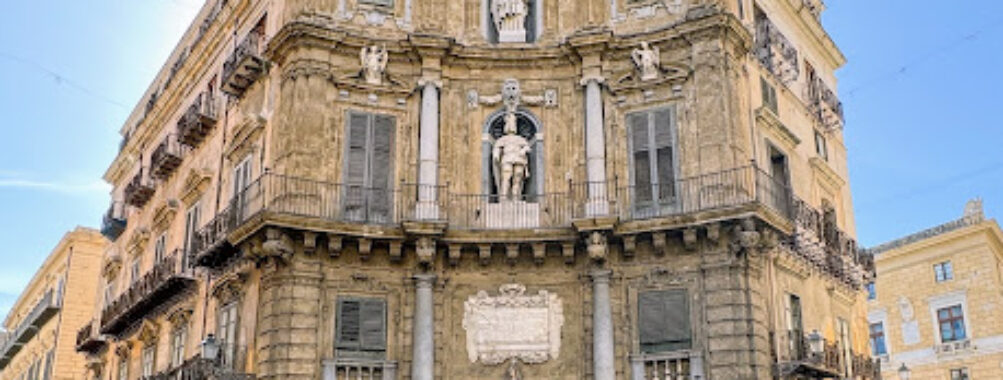
Quattro Canti
Table of Contents
Description
Quattro Canti is one of those places that feels like the beating heart of Palermo. It’s not just a square—it’s a stage, a living piece of baroque theater where the city itself seems to pause and pose for you. Officially called Piazza Vigliena, this octagonal junction was designed in the early 1600s, and it still manages to stop people in their tracks over 400 years later. Think four grand façades, each one dressed up with fountains, statues, and layers of history that climb skyward like a story told in stone.
Now, not everybody falls head over heels at first glance. Some people think it’s crowded, or too much of a tourist magnet. And yes, there are always people buzzing around—street performers, camera-toting travelers, locals zipping through on scooters. But that’s part of the charm. It’s messy, it’s loud, it’s alive. Personally, I found myself circling the square three or four times just to catch all the details. The statues of the Spanish kings, the patron saints, the fountains bubbling away—it’s like Palermo’s history condensed into one intersection.
What makes it even more interesting is that Quattro Canti was deliberately designed as a kind of open-air theater. The architects wanted people to feel like they were standing inside a giant stage set. And honestly, when the sunlight hits the sandstone façades in the late afternoon, you can almost hear the applause. It’s not perfect—there’s traffic noise, and sometimes you’ll have to dodge a tour group—but it’s unforgettable.
Key Features
- Baroque architecture with four symmetrical façades, each representing a different theme: seasons, Spanish kings, and Palermo’s patron saints.
- Four fountains at the base of each corner, adding movement and sound to the square.
- Octagonal layout that serves as a central junction for Palermo’s historic center.
- Rich symbolism layered into the statues and carvings, blending civic pride with religious devotion.
- Wheelchair accessible entrance, making it more inclusive for all travelers.
- Street performers and local vendors often add energy and spontaneity to the atmosphere.
Best Time to Visit
Timing makes a big difference here. Early mornings are surprisingly peaceful—you’ll see locals rushing to work, but the square itself is calm, and you can actually hear the fountains trickling. By midday, the sun is high, and the façades almost glow, but you’ll also be sharing the space with crowds. Personally, I think late afternoon is the sweet spot. The golden light softens the stone, shadows stretch across the square, and the whole place feels cinematic.
If you’re into photography, sunset is magic. And if you’re more of a night owl, don’t skip a nighttime visit. The façades are lit up, and while the traffic never really stops, the mood shifts into something more dramatic—almost theatrical. Just keep in mind that weekends can be packed, so if you want breathing room, aim for a weekday.
How to Get There
Reaching Quattro Canti is straightforward if you’re already wandering the historic center of Palermo. It sits right at the intersection of Via Maqueda and Corso Vittorio Emanuele, two of the city’s main arteries. You can walk here easily from the cathedral, the Teatro Massimo, or the markets. If you’re coming from further out, buses and taxis will drop you nearby, though traffic in central Palermo can be a headache.
I actually recommend walking if you can. The streets leading to the square are full of little surprises—street art, bakeries selling warm sfincione, and locals chatting on their doorsteps. It’s the kind of approach that makes the arrival at Quattro Canti feel like a reward rather than just another stop. Parking is possible on nearby streets, but it’s free-for-all chaos most of the time. Unless you’re very confident behind the wheel in Sicilian traffic, leave the car elsewhere.
Tips for Visiting
Here’s the thing about Quattro Canti: it’s beautiful, but it’s also a crossroads. That means you’ll be dodging cars, mopeds, and tour groups. So, first tip—watch your step and don’t stand in the middle of the road for too long trying to get the perfect selfie.
Second, slow down. It’s tempting to snap a few photos and move on, but the details here reward patience. Look up—really up—because the higher tiers of the façades are where the best carvings hide. And if you’re traveling with kids, they’ll probably enjoy the fountains more than the statues, so let them linger there.
If you’re sensitive to crowds, go early in the morning. If you want atmosphere, go late afternoon or evening. And don’t be afraid to circle back a second or third time during your stay in Palermo—you’ll notice something different each visit. I once spotted a tiny carving of a cherub I’d completely missed the first two times.
Lastly, keep a few coins handy. Street performers often set up here, and while you don’t have to give, tossing a euro or two their way makes the experience feel more communal. And honestly, who doesn’t enjoy a little live soundtrack while standing in the middle of a baroque masterpiece?
Location
Places to Stay Near Quattro Canti
Find and Book a Tour
Explore More Travel Guides
No reviews found! Be the first to review!